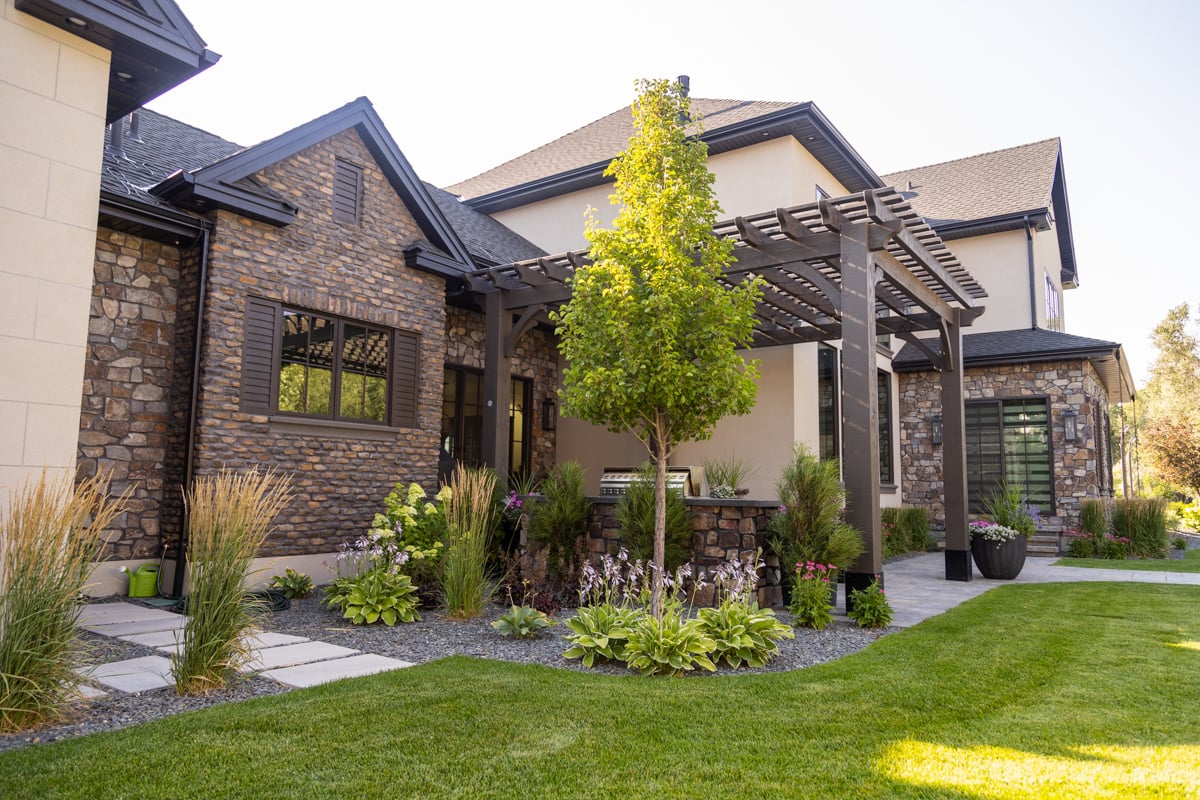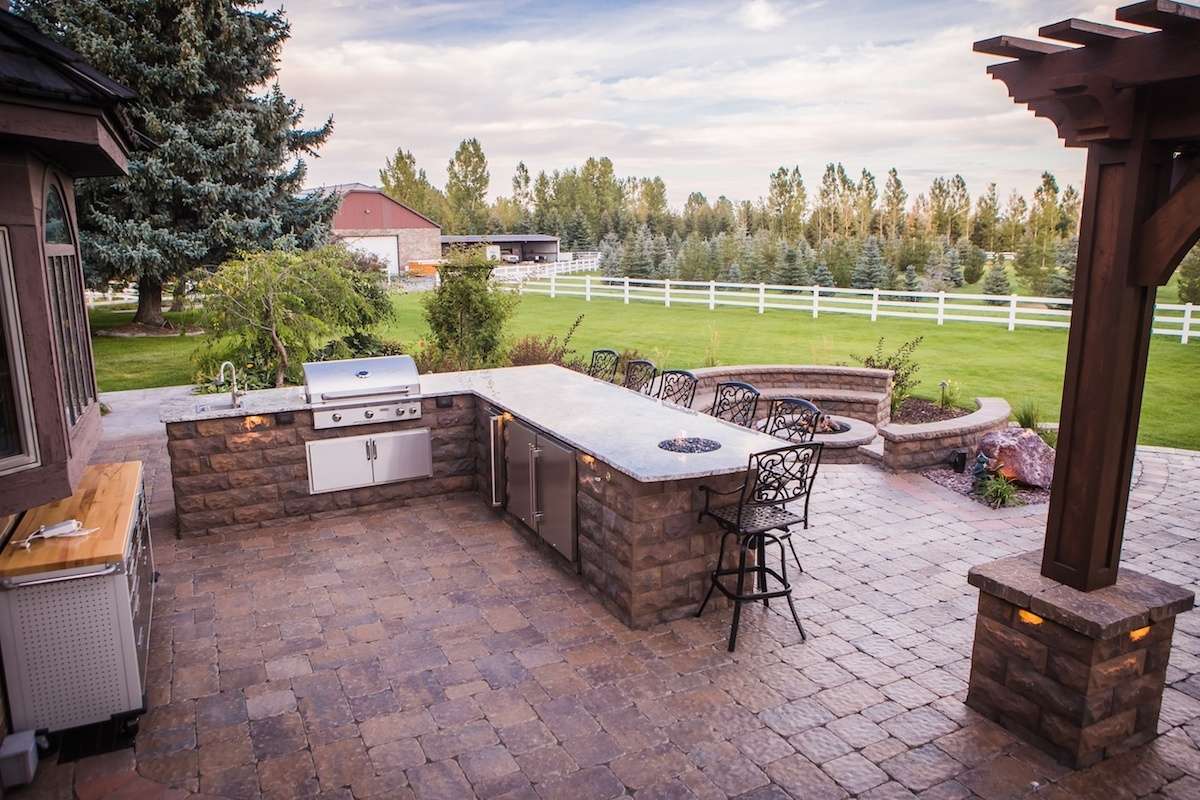

7 Ways To Deal With A Water-Damaged Lawn
If you’ve traded your flip-flops for hip waders for your stroll out to the backyard grill, you could use some help with lawn drainage.
Too much water lingering on your lawn is bad news.
Water-damaged grass has weakened roots, is yellow from lack of oxygen and invites damaging diseases like lawn fungus.
Can grass be overwatered? Absolutely. And if your lawn drainage isn’t great, that compounds the problem, creating waterlogged grass that can’t breathe, can’t grow and can die before your eyes.

How to repair a water-damaged lawn? First, you must fix the water issue causing the flooding. There's no sense trying to fix a flooded lawn if it will start holding water again.
Luckily, there are plenty of great solutions: French drains, lawn aeration, collection boxes, dry creek beds, and more.
Keep reading to learn more about drainage for flooded lawns, including:
- How to amend compacted soil
- Two ways to aerate compacted soil
- How a French drain can help
- Do you need an NDS flow well?
- Dry stream beds
- Collection boxes
- How to repair a water-damaged lawn
- How a rain sensor can help
First Up: Tackle That Drainage Problem
How do you fix a lawn that holds water? A landscaping pro can assess your soggy lawn and your drainage situation and recommend several solutions. Among them:
1. Amend Compacted Soil
If your soil is dense and compacted, water has difficulty descending through it.
Try amending the soil with looser materials like sand, loam, and compost so water can more easily pass through for better lawn drainage.
2. Aerate Compacted Soil
When the soil becomes compacted, the lawn gasps for air. Its roots can't take in water or nutrients, which weakens the turf.
Meanwhile, water builds up because water can’t drain well through dense, compacted soil.

Lawn aeration uses a machine to pull out plugs of soil, creating spaces for air and water to penetrate.
Lawn aeration also helps break down thatch - a common lawn problem in Idaho - that layer of dead grass and stems that sits between the grass blades and the soil and prevents good lawn drainage.
3. Liquid Aeration
Here’s a cool thing: liquid aeration. No holes are needed.
An organic mix of chemicals is applied to the grass with liquid aeration. It breaks down the thatch layer and allows the lawn’s roots to breathe.
4. French Drains
A French drain sounds kind of fancy, but is a gravel-filled trench with a perforated pipe inside. It uses gravity to divert your yard’s excess water, preventing flooded lawns.
Water flows into the trench, soaks down through the gravel and into the pipe, which diverts it away from your yard.
5. NDS Flo-Well
This manufactured dry well collects, retains and discharges excess water, without the use of gravel. Easily installed and made from 100% recycled materials, it filters water naturally through the subsurface and discharges excess water away from your lawn.
6. Dry Creek Bed
A dry creek bed? What’s the point? It’s a handy drainage solution for flooded lawns that also looks great.
Constructed from rocks of assorted sizes, a dry stream bed provides a planned place for extra water to go so it doesn’t create a waterlogged lawn.
It’s an attractive landscaping element that needs no maintenance when it's not absorbing excess water.
7. Collection Boxes
Collection boxes, called catch basins, are common lawn drainage solutions.
It’s a 12-inch-square box with a grate on top and a drainage pipe that slopes away from the basin.
Placed in the ground at a low point on your property, they collect water through the grate. Any debris settles to the bottom while water drains out of the pipe and is diverted to the street storm drains.
Next Up: How to Repair a Water-Damaged Lawn
Once you’ve fixed the drainage issue, repairing that flooded lawn is safe.
In the early spring here in Idaho, lawns flooded by rain, overwatered by overanxious homeowners or waterlogged by poor drainage can withstand submerging for a few days, because they haven’t yet entered active growth.
But in the summer, when it’s hot and sunny, flooded lawns can sustain more damage.

Roots can’t breathe. Fungus sets in. Things can go south fast.
Once you’ve fixed the water issue and let your soggy and damaged lawn dry out, wait until temperatures cool in the early fall, then plan to re-seed.
Lawns seeded in fall have a much better chance of getting established.
Apply the Proper Fertilizer
After you seed, apply a 16-16-16 fertilizer to promote new top growth and healthy root systems. Your goal: two treatments about 4-6 weeks apart.
Once the lawn gets established, use fertilizers that contain more iron and more slow-release products to keep the grass greener for longer.

But when it's newly seeded, the green color isn't necessarily the most important goal, which is why you use the 16-16-16 at first.
Are You Overwatering Your Lawn? Get a Rain Sensor
Sometimes Mother Nature drops plenty of rain on your lawn — even too much, sometimes— but you’re busy and not paying attention, so your irrigation system keeps on chugging.
Suddenly, your poor lawn is waterlogged and you’ve wasted a ton of water.
Simple, inexpensive devices connected to your irrigation system, rain sensors are activated by rainfall, and when they sense rain, they shut the irrigation system down to prevent overwatering.
No more flooded lawn, no more wasted water and money.
Need Help with a Water-damaged Lawn? Trust Outback
Landscapes that don’t drain well cause problems that go beyond soggy lawns.
Poor drainage can cause water damage problems inside the house, too.
Too much water creates mold and mildew and causes cracks in interior walls and exterior surfaces. Damp conditions can encourage mosquitoes and rodents, too.
You don’t want to put this problem off.

Need flooded lawn repair in Boise and Idaho Falls?
Give us a call. We’ll help you fix your flooded lawn — and get to the bottom of your drainage problem to keep it from happening again.
Outback Landscape is a full-service maintenance, design, and landscape installation company serving Southeast Idaho and Wyoming.
We install beautiful, functional landscapes. We’ll stay with you for the long haul, taking care of your property through all four seasons — including all the landscape challenges of summer. Reach us by phone at (208) 656-3220 or request a consultation online. We’d love to hear from you.
If You're Looking For a Sign, This is It.
Seriously, that lawn isn't getting any better on it's own. Mrs. Jones just called the HOA on you
.jpg?width=480&name=Chase%20Coates%20Team%20Portrait%202%20(2).jpg)
Chase Coates
Chase Coates is the owner of Outback Landscape in Idaho Falls, Idaho.


Brick Pavers vs Stamped Concrete: Pros, Cons, and Costs
.jpg)



